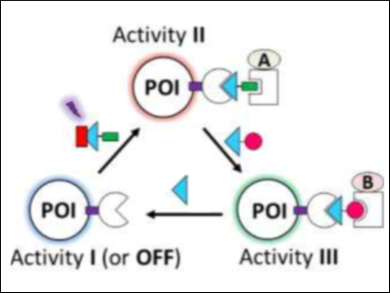How proteins or organelles move through a living cell plays a crucial role in controlling various cellular processes and in the development of diseases. Chemically induced dimerization is a tool to modulate protein function by bringing two proteins close together. Such approaches have been successfully used to study relatively simple cellular processes. However, the analysis of complex processes that involve the cycling, trafficking, or shuttling of signal molecules or organelles between different cell compartments remains a major challenge and could benefit from a more fine-grained activity control.
Yaowen Wu, Max Planck Institute of Molecular Physiology, Dortmund, Germany, and colleagues have developed a method termed “Multi-directional Activity Control” (MAC) using a photoactivatable, dual-chemically induced dimerization (pdCID) system. The approach combines different dimerizers that connect light-induced and chemically induced dimerization reactions. The dimerizer systems are composed of, e.g., an SLF*‐TMP (S*T) dimerizer and a NvocTMP‐Cl photocaged dimerizer (pictured below).
With previously available systems, the activity of a protein of interest (POI) could just be turned on or off using dimerization with other proteins. The developed MAC approach, in contrast, allows multiple layers of control over protein activity (pictured above).

The researchers used this approach to control the positioning of organelles and proteins at multiple locations in a single cell. They achieved multiple cycles of shuttling the protein Rac1 among the cytosol, plasma membrane, and nucleus in a single cell. They were also able to control the transport of peroxisomes (a cellular organelle involved in oxidization of molecules) in two directions, that is, to the cell periphery and then back to the cell body.
“These new tools are useful for studying how proteins or organelles mutually affect their local subcellular environment, and for emulating or interfering with disease conditions to study their mechanisms”, the researchers state.
- Multi-directional activity control (MAC) of cellular processes enabled by a versatile chemo-optogenetic approach,
Yaowen Wu, Xi Chen, Muthukumaran Venkatachalapathy, Leif Dehmelt,
Angew. Chem. Int. Ed. 2018.
https://doi.org/10.1002/anie.201806976




